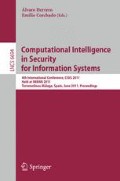Abstract
Intrusion Detection Systems (IDS) are widely deployed in computer networks. As modern attacks are getting more sophisticated and the number of sensors and network nodes grows, the problem of false positives and alert analysis becomes more difficult to solve. Alert correlation was proposed to analyze alerts and to decrease false positives. Knowledge about the target system or environment is usually necessary for efficient alert correlation. For representing the environment information as well as potential exploits, the existing vulnerabilities and their Attack Graph (AG) is used. It is useful for networks to generate an AG and to organize certain vulnerabilities in a reasonable way. In this paper, we design a correlation algorithm based on AGs that is capable of detecting multiple attack scenarios for forensic analysis. It can be parameterized to adjust the robustness and accuracy. A formal model of the algorithm is presented and an implementation is tested to analyze the different parameters on a real set of alerts from a local network.
Access this chapter
Tax calculation will be finalised at checkout
Purchases are for personal use only
Preview
Unable to display preview. Download preview PDF.
References
Northcutt, S., Novak, J.: Network Intrusion Detection: An Analyst’s Handbook. New Riders Publishing, Thousand Oaks (2002)
Kruegel, C., Valuer, F., Vigna, G.: Intrusion Detection and Correlation: Challenges and Solutions. AIS, vol. 14. Springer, Heidelberg (2005)
Ou, X., Govindavajhala, S., Appel, A.: MulVAL: A Logic-based Network Security Analyzer. In: Proceedings of 14th USENIX Security Symposium, p. 8. USENIX Association, Baltimore (2005)
Noel, S., Jajodia, S.: Managing attack graph complexity through visual hierarchical aggregation. In: Proceedings of Workshop on Visualization and Data Mining for Computer Security (VizSEC/DMSEC 2004), pp. 109–118. ACM, Washington DC (2004)
Wang, L., Liu, A., Jajodia, S.: Using attack graphs for correlation, hypothesizing, and predicting intrusion alerts. Journal of Computer Communications 29(15), 2917–2933 (2006)
Roschke, S., Cheng, F., Meinel, C.: A Flexible and Efficient Alert Correlation Platform for Distributed IDS. In: Proceedings of the 4th International Conference on Network and System Security (NSS 2010), pp. 24–31. IEEE Press, Melbourne (2010)
Sheyner, O., Haines, J., Jha, S., Lippmann, R., Wing, J.M.: Automated Generation and Analysis of Attack Graphs. In: Proceedings of the 2002 IEEE Symposium on Security and Privacy (S&P 2002), pp. 273–284. IEEE Press, Washington, DC (2002)
Sadoddin, R., Ghorbani, A.: Alert Correlation Survey: Framework and Techniques. In: Proceedings of the International Conference on Privacy, Security and Trust (PST 2006), pp. 1–10. ACM Press, Markham (2006)
Debar, H., Curry, D., Feinstein, B.: The Intrusion Detection Message Exchange Format, Internet Draft. Technical Report, IETF Intrusion Detection Exchange Format Working Group (July 2004)
Mitre Corporation: Common vulnerabilities and exposures CVE Website, http://cve.mitre.org/ (accessed March 2009)
Valdes, A., Skinner, K.: Probabilistic alert correlation. In: Lee, W., Mé, L., Wespi, A. (eds.) RAID 2001. LNCS, vol. 2212, pp. 54–68. Springer, Heidelberg (2001)
Julisch, K.: Clustering intrusion detection alarms to support root cause analysis. ACM Transactions on Information and System Security 6(4), 443–471 (2003)
Debar, H., Wespi, A.: Aggregation and correlation of intrusion-detection alerts. In: Lee, W., Mé, L., Wespi, A. (eds.) RAID 2001. LNCS, vol. 2212, pp. 85–103. Springer, Heidelberg (2001)
Al-Mamory, S.O., Zhang, H.: IDS alerts correlation using grammar-based approach. Journal of Computer Virology 5(4), 271–282 (2009)
Ning, P., Cui, Y., Reeves, D.: Constructing attack scenarios through correlation of intrusion alerts. In: Proceedings of the 9th ACM Conference on Computer and Communications Security (CCS 2002), pp. 245–254. ACM Press, Washington, DC (2002)
Qin, X.: A Probabilistic-Based Framework for INFOSEC Alert Correlation, PhD thesis, Georgia Institute of Technology (2005)
Qin, X.: Statistical causality analysis of INFOSEC alert data. In: Vigna, G., Krügel, C., Jonsson, E. (eds.) RAID 2003. LNCS, vol. 2820, pp. 73–93. Springer, Heidelberg (2003)
Oliner, A.J., Kulkarni, A.V., Aiken, A.: Community epidemic detection using time-correlated anomalies. In: Jha, S., Sommer, R., Kreibich, C. (eds.) RAID 2010. LNCS, vol. 6307, pp. 360–381. Springer, Heidelberg (2010)
Manganaris, S., Christensen, M., Zerkle, D., Hermiz, K.: A data mining analysis of rtid alarms. Computer Networks 34(4), 571–577 (2000)
Siraj, A., Vaughn, R.B.: A cognitive model for alert correlation in a distributed environment. In: Kantor, P., Muresan, G., Roberts, F., Zeng, D.D., Wang, F.-Y., Chen, H., Merkle, R.C. (eds.) ISI 2005. LNCS, vol. 3495, pp. 218–230. Springer, Heidelberg (2005)
Ning, P., Xu, D., Healey, C.G., Amant, R.S.: Building attack scenarios through integration of complementary alert correlation method. In: Proceedings of the Network and Distributed System Security Symposium (NDSS 2004). The Internet Society, San Diego (2004)
Porras, P.A., Fong, M.W., Valdes, A.: A mission-impact-based approach to INFOSEC alarm correlation. In: Wespi, A., Vigna, G., Deri, L. (eds.) RAID 2002. LNCS, vol. 2516, pp. 95–114. Springer, Heidelberg (2002)
Snort IDS: WEBSITE, http://www.snort.org/ (accessed November 2009)
Floyd, R.: Algorithm 97 (SHORTEST PATH). Communications of the ACM 5(6), 345 (1962)
Warshall, S.: A Theorem on Boolean Matrices. Journal of the ACM 9(1), 11–12 (1962)
Author information
Authors and Affiliations
Editor information
Editors and Affiliations
Rights and permissions
Copyright information
© 2011 Springer-Verlag Berlin Heidelberg
About this paper
Cite this paper
Roschke, S., Cheng, F., Meinel, C. (2011). A New Alert Correlation Algorithm Based on Attack Graph. In: Herrero, Á., Corchado, E. (eds) Computational Intelligence in Security for Information Systems. Lecture Notes in Computer Science, vol 6694. Springer, Berlin, Heidelberg. https://doi.org/10.1007/978-3-642-21323-6_8
Download citation
DOI: https://doi.org/10.1007/978-3-642-21323-6_8
Publisher Name: Springer, Berlin, Heidelberg
Print ISBN: 978-3-642-21322-9
Online ISBN: 978-3-642-21323-6
eBook Packages: Computer ScienceComputer Science (R0)

